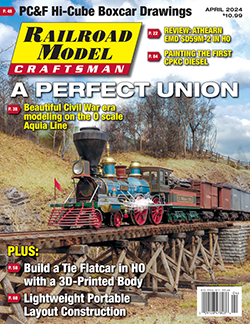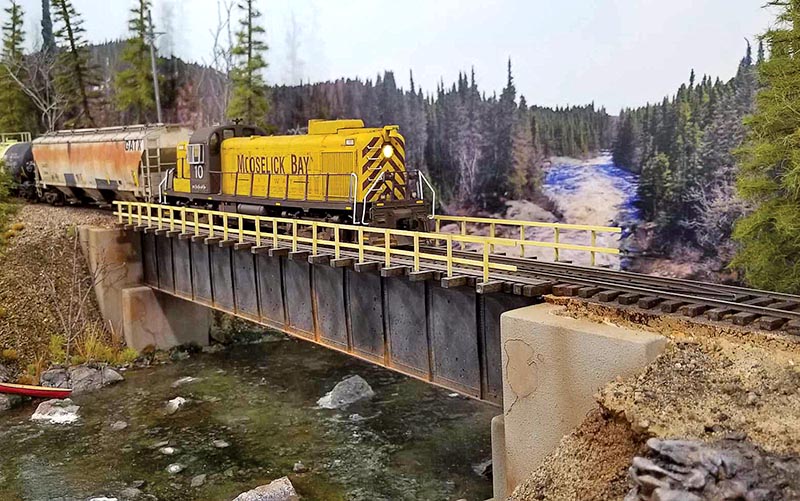 I’m the type of person that is easily distracted. And when it comes to a hobby like model railroading, let’s face it: there are a lot of interesting things that can cause distraction. For example, I like prototype modeling because it puts restraints on a modeler—whether it be how a railroad looks and functions, the industries it serves, or the varied scenes it passes through. But in contrast, I also like freelancing because it affords the opportunity to develop your own reality and focus on things that grab our attention and inspire our imagination.
I’m the type of person that is easily distracted. And when it comes to a hobby like model railroading, let’s face it: there are a lot of interesting things that can cause distraction. For example, I like prototype modeling because it puts restraints on a modeler—whether it be how a railroad looks and functions, the industries it serves, or the varied scenes it passes through. But in contrast, I also like freelancing because it affords the opportunity to develop your own reality and focus on things that grab our attention and inspire our imagination.
When I made the decision to model a prototype branch line of the Iowa Interstate Railroad many years ago, I was perfectly happy with my choice. I didn’t have to fret about what paint scheme to apply to the locomotives, or what cars and industries to choose. I only had to do some basic research to discover the history of the branch, set a time frame to model, and I was off and running. Since I was modeling a relatively short branch that didn’t move that many cars, I decided that HO was the perfect scale for my modest space. I knew that I would never lack for modeling supplies or inspiration from other modelers. Everything seemed to fall in place and I proceeded to do what every good model railroader does – design a track plan, build benchwork, wire, lay track, and start scenery. But, alas, something was amiss.
Remember, I’m the type of person who is easily distracted by all the wonderful things this hobby has to offer. I had pounded my prototype stake into the ground and was happily pursuing the dream of a fully scenicked operating layout, or so I thought. Sometimes distractions can turn into dissatisfactions.
After roughly six years of working on the layout, I started to become very interested in following armor modelers on YouTube and through several books. I was interested in learning more advanced techniques in weathering, and the military modelers seemed to offer many compelling step-by-steps. These techniques were different from many of the traditional approaches I had known, and the results were amazing. And, most of the models they worked on were done in 1:35 scale. Along with the larger scale, armor modelers typically build small dioramas to “set the scene” for their models. These dioramas intrigued me because they were compact, succinct, and followed a single theme. When completed, the modeler moved on to another diorama of a different theme. This experience, along with my propensity to be drawn to many different interests, planted a seed in my mind that wouldn’t go away. I suddenly found myself becoming somewhat dissatisfied with a single-themed railroad. I felt restricted and boxed in. I was envious of the armor modelers who enjoyed bouncing from one theme (or interest) to another with ease, while I was bound to my prototype theme like glue. Was there a solution to a dilemma like this?
About the same time that I was investigating what the armor modelers had to offer, I was invited to give a clinic about my layout at the Twin Cities Modelers Retreat. There were two S scale modelers displaying their engines and rolling stock, and I became instantly enamored by the larger scale. Because I had been absorbing so much of what the armor modelers were presenting in 1:35 scale, those 1:64 S scale models made a significant impression. I realized at that meet that I could satisfy my drive to distraction by modeling in a larger scale along with retaining my home layout. Why not? For some odd reason, I had been holding on to the thought that keeping to one scale is preferable. Now I saw that being a “rubber gauger” was a viable option.
I made the decision to model in 2-rail O scale. It was the right size because I could easily translate what I have learned from the 1:35 armor modelers to 1:48. The scale is a welcome change from HO because of its sheer mass. Mass makes the cars seem heavier, you can add larger speakers inside locomotives to improve the sound experience immensely, and you can actually see details without having to resort to magnifying glasses. Surprisingly, such a large scale needn’t take up that much space. I took my cue, again, from the armor modelers and decided to create modest-sized dioramas that could be strung together at shows for display. Plus, I’m modeling a freelance railroad based on a Milwaukee Road branch line that I’m calling the Paint Creek & Waterville. The PC&W will be a hard-working line that looks fairly run-down, but is a complete fabrication from my imagination.
What a wonderful hobby we enjoy. I now bounce back and forth between my prototype layout and my freelance “dioramas.” Ah, the allure and satisfaction of being a “rubber gauger!” Maybe dabbling in another scale or prototype is just what you need, too. —Scott Thornton



